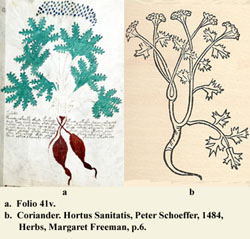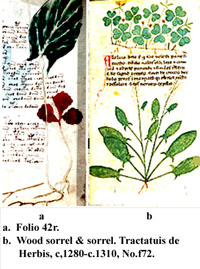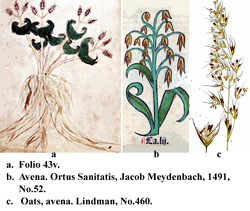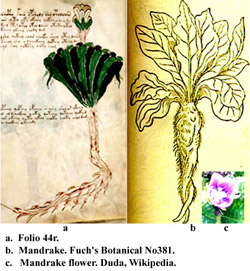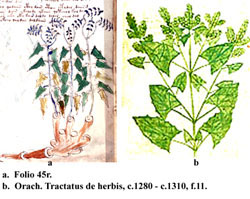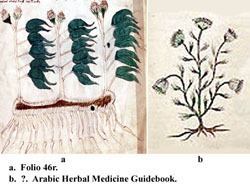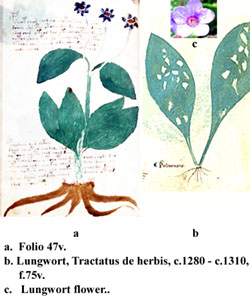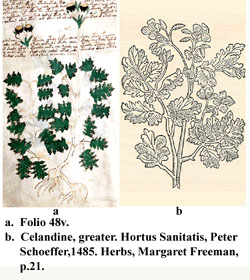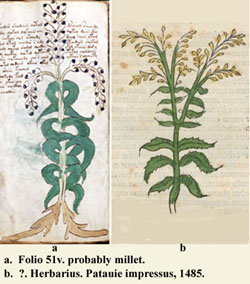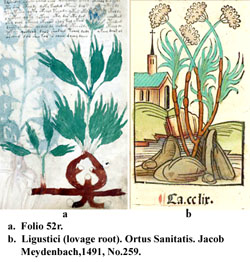The Voynich Botanical Plants
Folio 41v. Coriander (Coriandrum sativum). In the Middle Ages coriander seeds were used to flavor wine, preserves, soup and meat dishes. “One delectable dish was of fowl and veal and cooked with bacon in water and wine and a spice that is hight red coriander and garnished with pomegranate seeds and fried almonds. The herbalist states that “the seeds are good to do away with the fevers that come on the third day and when drunken with honey will slay worms.” (2) (B)
Folio 42r. Wood sorrel and sorrel (Oxalis acetosella and Rumex acetosa). As their generic names indicate, both plants taste sour due to the presence of oxalic acid. In the past, an oxalate, sal acetosella was extracted from wood sorrel by boiling. The leaves of both plants should be eaten sparingly to avoid forming calcium oxalate stones in the kidneys. (B)
Folio 43v. Wild oats (Avena sterilis). Oats were domesticated in Europe during the Bronze Age. It grows in cooler climates and under wetter conditions than the other cereals like wheat, rye or barley. Oats are gluten free and are used as a cereal, and in baked goods for individuals who are gluten intolerant. Oats may be used as a malt for brewing beer. (1) (B)
Folio 44r. Mandrake (Mandragora officinarum). In the Middle Ages the people believed that the forked, parsnip-like taproot of this plant resembling a human form gave the plant magical powers. The aphrodisiac properties of the mandrake are referred to in Genesis. The Romans gave the juice from the root to patients as an anesthetic during operations. Dioscorides describes how it is “given to such as cannot sleep, or are grievously pained, and upon whom are cut or cauterized they wish to make a non feeling pain. He explains who ever eats it is non sensible for 3-4 hours.” (2) (B)
Folio 45r. Orach (Atriplex hortensis). According to the book of Job, the leafy vegetable was eaten by outcasts. The leaves have a salty spinach-like taste. (1) (B)
Folio 46r. The identity of this plant is not known. (B)
Folio 47v. Lungwort (Pulmonaria officinalis). The botanical name Pulmonaria, is derived from Latin for lung. The speckeled, alternate, oval leaves resemble a diseased or ulcerated lung. This plant was therefore used to treat pulmonary infections including tuberculosis, asthma and coughs. It contains toxic components and should be used with care. (B)
Folio 48v. Celandine (Chelidonium majus). Bancker’s Herbal, quoting Galen, says that celandine is “good for sore eyes. It is good for the canker in a man’s mouth and for him that hath drunken venom. Also take selondyne (celandine) and draw out the juice thereof and meddle it with white wine and anoint the visage therewith and it shall do away with freckles of the visage.” (2) (B)
Folio 51v. Millet (Setaria italica). Millet was one of the staple grains of Europe until the introduction of corn and rice. It was also one of the first grains to be cultivated. Millet contains no gluten and therefore can only be used to make flat breads that do not require yeast. Its protein content is similar to wheat, it is rich in the B vitamins and a number of important minerals like iron and calcium and phosphorous. As it is gluten free it can be used for people with celiac disease. (1) (B)
Folio 52r. Lovage (Levisticum officinale). Lovage leaves are used in salads and soups. The roots taste rather like celery and may be cooked as a vegetable. The seeds resemble fennel seeds and are used as a spice. Lovage tea can be applied to wounds as an antiseptic or drunk to stimulate the digestion. (1) (B)
